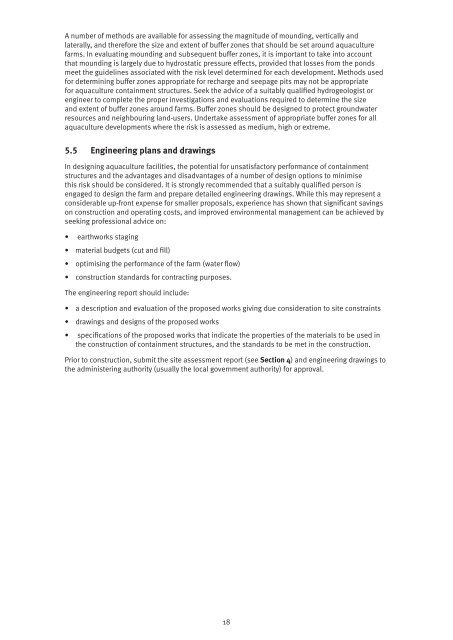Guidelines for constructing and maintaining aquaculture ...
Guidelines for constructing and maintaining aquaculture ...
Guidelines for constructing and maintaining aquaculture ...
You also want an ePaper? Increase the reach of your titles
YUMPU automatically turns print PDFs into web optimized ePapers that Google loves.
A number of methods are available <strong>for</strong> assessing the magnitude of mounding, vertically <strong>and</strong><br />
laterally, <strong>and</strong> there<strong>for</strong>e the size <strong>and</strong> extent of buffer zones that should be set around <strong>aquaculture</strong><br />
farms. In evaluating mounding <strong>and</strong> subsequent buffer zones, it is important to take into account<br />
that mounding is largely due to hydrostatic pressure effects, provided that losses from the ponds<br />
meet the guidelines associated with the risk level determined <strong>for</strong> each development. Methods used<br />
<strong>for</strong> determining buffer zones appropriate <strong>for</strong> recharge <strong>and</strong> seepage pits may not be appropriate<br />
<strong>for</strong> <strong>aquaculture</strong> containment structures. Seek the advice of a suitably qualified hydrogeologist or<br />
engineer to complete the proper investigations <strong>and</strong> evaluations required to determine the size<br />
<strong>and</strong> extent of buffer zones around farms. Buffer zones should be designed to protect groundwater<br />
resources <strong>and</strong> neighbouring l<strong>and</strong>-users. Undertake assessment of appropriate buffer zones <strong>for</strong> all<br />
<strong>aquaculture</strong> developments where the risk is assessed as medium, high or extreme.<br />
5.5 Engineering plans <strong>and</strong> drawings<br />
In designing <strong>aquaculture</strong> facilities, the potential <strong>for</strong> unsatisfactory per<strong>for</strong>mance of containment<br />
structures <strong>and</strong> the advantages <strong>and</strong> disadvantages of a number of design options to minimise<br />
this risk should be considered. It is strongly recommended that a suitably qualified person is<br />
engaged to design the farm <strong>and</strong> prepare detailed engineering drawings. While this may represent a<br />
considerable up-front expense <strong>for</strong> smaller proposals, experience has shown that significant savings<br />
on construction <strong>and</strong> operating costs, <strong>and</strong> improved environmental management can be achieved by<br />
seeking professional advice on:<br />
• earthworks staging<br />
• material budgets (cut <strong>and</strong> fill)<br />
• optimising the per<strong>for</strong>mance of the farm (water flow)<br />
• construction st<strong>and</strong>ards <strong>for</strong> contracting purposes.<br />
The engineering report should include:<br />
• a description <strong>and</strong> evaluation of the proposed works giving due consideration to site constraints<br />
• drawings <strong>and</strong> designs of the proposed works<br />
• specifications of the proposed works that indicate the properties of the materials to be used in<br />
the construction of containment structures, <strong>and</strong> the st<strong>and</strong>ards to be met in the construction.<br />
Prior to construction, submit the site assessment report (see Section 4) <strong>and</strong> engineering drawings to<br />
the administering authority (usually the local government authority) <strong>for</strong> approval.<br />
18

















